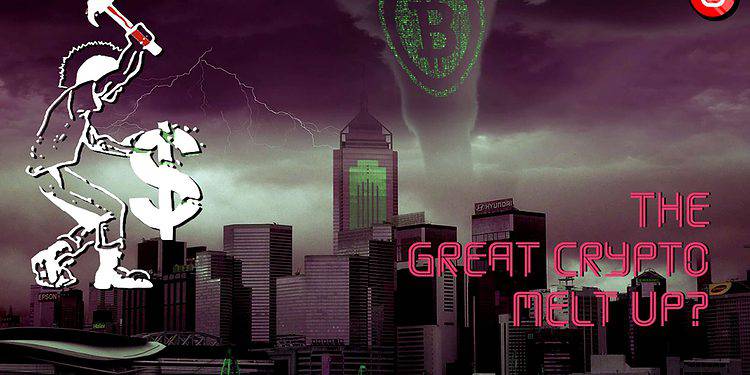Article contributed by Tin Money. Follow them on Medium here.
Cover Image: PixTeller
Winter Has Come
What requires no speculation is assessing the state of the global economy. It’s terribad. The second and third largest economies (China and the European Union) are melting down before our eyes.
The USA isn’t far behind. The really screwy thing is, for the first time in a long time, there is a divergence in central bank policies.
Since them Wall Street Bois collapsed the global economy back in ‘08, the central bankers of the world have roughly coordinated monetary policy. That policy has been permissive, to say the least.
This is what it looks like. The blue line is the United States. The other countries are: Japan (orange), China (teal), France (purple), and Germany (yellow).
Image: TradingView
Pretty spiffy, eh? All those unique cultures and languages and different policy goals coming together to debase their currencies at almost exactly the same rate.
Weird how that works.
In case you were wondering, that chart represents a roughly 1800% increase in the money supply in 20 years. That worked out great for the billionaire class.
Pretty much sucks for everyone else.
Life at the zero-bound
The Japanese are the world leading experts at creating a zombie economy. Back in the 1990s, Japan embarked on what would become the norm for the rest of the world a decade later.
Tell me if any of this sounds familiar: Artificially low interest rates encouraged speculators to ape in to the stock and real estate markets on leverage. Both skyrocketed to ridiculous highs.
The Japanese central bank tried to “cool-off” markets with interest rate hikes. This caused a massive debt crisis as leveraged speculators started defaulting.
The real estate and stock markets completely collapsed. In response, the central bank lowered rates and started bailing out debt straddled “zombie” companies.
But since rates were already too low to begin with, the zero interest rates failed to encourage more debt fuelled speculation. So the best they could achieve is keeping debt riddled, non-productive zombie companies alive on a never-ending stream of cheap money.
Image: ImgFlip
That’s the zero-bound in a nutshell. It’s also what we call “moral hazard.” It’s just like a friend that keeps borrowing money, but always blows their pay check on stupid stuff. If you keep lending them money they’ll never stop.
Compare to the United States. A series of not great things happened right around 2000. The dot-com bubble burst, 9/11 happened, followed by the invasion of Afghanistan.
The Federal Reserve (the Fed) lowered rates and kept them low for way too long. Leveraged speculators drove the stock and real estate markets to ridiculous highs.
The Fed tried to “cool-off” markets by raising rates. This caused a massive debt crisis as leveraged speculators started defaulting.
The real estate and stock markets completely collapsed. In response, the central bank lowered rates and started bailing out debt straddled “zombie” companies.
But the difference was, in 2008 the whole world had gotten into the game. Thanks to the over-the-counter (OTC) derivatives market, the entire global economy had become a debt-ridden casino.
Image: Demonocracy
While the image above says “$1 Quadrillion”, the real notional value of the OTC derivatives market is closer to $600 Trillion. When that started unwinding in 2008 it was game over for the global economy.
That’s why the central bankers went on an absolute spree debasing their currencies. We can only speculate what the world would look like if they had let the casino fail.
Suffice to say, it would have been ugly.
Trouble is, much like Japan has learned over the last thirty years, there’s no way out of this mess now. The real problem is when something else happens, like a global pandemic, for instance.
The dumb thing about zombie movies
If there was ever a zombie apocalypse, it seems the smart thing to do would be to sit back and wait for them to starve. Once the zombies run out of brains to eat, they’ll die.
Of course, that doesn’t make for a very good story. So the writers come up with some device to keep the zombies going despite the obvious problem of no zombie food. That’s just how zombie movies work.
Same is true for over-leveraged, non-productive zombie companies. We could have sat back and let them starve. Once the zombie companies had run out of cheap money to borrow, they would have died.
Unlike the movies, however, zombie companies don’t need to come up with some new story device to avoid the obvious. They have regulatory capture on their side.
Remember, the architect of the 2008 bailouts was Treasury Secretary Hank Paulson. Mr. Paulson also just happened to previously be the CEO of Goldman-Sachs.
And when given the choice between letting Goldman-Sachs and the rest of his bank buddies go down in flames, or putting every global taxpayer on the hook for their recklessness, he chose the latter.
Keep in mind, 2008 was NOT a “black swan” event. That was an inevitable outcome from a decades of moral hazard. COVID-19 was a black swan.
And right now, we all get a front-row seat to the aftermath of that black swan nose-diving into decades of moral hazard. The playbook hasn’t changed, but this time the outcome might be different.
Image: ImgFlip
The Global Economic Playbook
The whole world is likely to mirror Japan’s economy for the foreseeable future. The playbook is pretty simple: keep rates too low for too long, pump markets full of funny money, wait until they boil over, raise rates, crash the markets, buy all the trash debt and malinvestment at taxpayer expense, repeat.
Sooner or later, when the markets only function on funny money, the printer stays on forever, the zombie companies keep wasting money and the markets just sputter along, slowly bleeding out.
To be fair, the Nikkei Index did pump with the COVID stimulus. Still has never regained the highs from the 1980s. See:
Image: Yahoo Finance
Ask yourself this: would you invest in a market that slowly cratered for thirty years and still hasn’t fully recovered?
Well, right now the world is where Japan was in the 1980s. I’m betting when global markets crash, the bailouts will come, the printer will be on forever, and the markets will just sputter along, slowly bleeding out for decades.
But the key point is, markets have to crash first. Without the crash, the playbook can’t work because inflation will tip the board over and scatter all the pieces.
Up until now, the central bankers have been following the Japan playbook to a “T”. But risk-on investors in the USA aren’t playing ball. The Fed keeps raising rates and investors keep pumping the markets.
Yes, the markets have come down, but they haven’t crashed. So now the Fed is telling investors in no uncertain terms they’re going to crash the markets.
Trouble is, investors keep calling their bluff. Everyone knows the money printer is going to come back on sooner or later, so every dip they ape back in expecting an interest rate reversal.
This forces the Fed to tighten the screws even more. But the more they tighten, the more the risk-on crowd expects a turnaround. It’s a game of chicken that can only end in disaster.
Thing is, there is only so far the Fed can tighten before the crash becomes a collapse. Above a certain interest rate, the cost of servicing the national debt becomes an unbearable weight.
If we get that high, which is roughly around a 4% interest rate, you can forget a “soft landing”. The crash will be fast, it will be brutal, and it will be shocking. But there’s one asset class that just might do something different this time around.
Crypto.
Image: ImgFlip
Code is Law
Despite their volatility, crypto markets are remarkably efficient.
Remember when Lehman Brothers collapsed? The shockwave that went through Trad-Fi ended up triggering a global economic meltdown.
At the time, Lehman Brothers had a market cap of around $60 Billion. When Terra Luna collapsed, it too had a market cap of around $60 Billion.
Did that trigger a global economic meltdown? Nope. The crypto markets reacted. But capital got reallocated, the crappy players (e.g., 3AC, Celsius, Voyager) got washed out and crypto kept going.
Uniswap didn’t collapse. Pancake Swap didn’t collapse. Curve didn’t, nor did any other code-driven DAO. Why? Because the rules are coded in.
Voyager was lending out billions on a handshake. Maker DAO won’t do that, nor will Curve, or Convex. They can’t. It’s not in the code.
The future of Trad-Fi is uncertain because people have been making terrible decisions with no consequences. Crypto doesn’t allow that.
And the same people that have been making those terrible decisions in Trad-Fi have boxed themselves in. They don’t have an escape route without torching the global economy.
The ones at the top are doing great. But the cost to the rest of the world is terrible. A declining standard of living, the constant loss of purchasing power, and forced austerity is all we have to look forward to.
Maybe.
Thing is, as the world realises what a bad deal they’re getting, there is an alternative. That alternative wasn’t available in the last crash.
It’s called Bitcoin.
And by extension, the rest of the crypto markets as well. Bitcoin and the broader crypto markets are zero-sum. Money comes in, price goes up. Money goes out, price goes down.
Simple as that.
But, if my thesis holds true, and markets crash, get bailed out and then range sideways for decades, while your home currency is debasing at 10–15% per year, what incentive would you have to buy into the markets — stocks, real estate, or otherwise?
Remember this chart?
Image: Yahoo Finance
Chances are good that’s what global equities markets (including in the USA) are probably going to look like after this next crash. Think about that for a second. Imagine your 401K, or your stock portfolio slowly bleeding out for the next twenty years before you see any gains.
That’s not great.
But before crypto, you wouldn’t have had a choice. It’s the markets, or it’s watch your purchasing power evaporate. But if markets fail to go up, up, up like they have historically, what are we to do?
I think people will start buying crypto.
It’s a market without borders. It’s open 24 hours a day, seven days a week. It can be manipulated, but only within the rules in the code. And it’s on everyone’s radar.
That calculus is as true for the individual, as it is for the institutions, as it is for the nation-states of the world that are currently beholden to the United States and the SWIFT banking system.
Crypto is not ready for an easy primetime adoption. It’s too esoteric and technical for the average Joe and Jane.
Meaning, if the central bankers can figure out a way to wiggle out of this mess and squeeze out another pump, it’ll probably be a while before crypto goes mainstream.
But if the central bankers can’t figure out a way out of the mess, well, necessity is a mother.
And if things keep going sideways for the Fed, and they end up over-tightening monetary policy and create a depression-era style shock, I think crypto might actually pump.
Like hard.
Simply put, where else are you (and everyone else) going to put your (their) money? An economic crash is coming, no doubt. Whether this week, this year, or this decade, it’s coming. It’s as sure as I’m typing this sentence.
And yet, this time really is different. This time there is a functioning, decentralised global financial network with nearly unlimited possibilities. It’s not a theory, and it’s not some far-fetched idea.
It’s there right now. It’s working. It’s resilient. And it’s just a click away from any network connected computing device.
Of course, the next crash might just zero the whole game out. That’s definitely possible. But on balance, I very strongly believe having a stake in the game will be critical to my financial survival in the years to come.
Winter is here. And like the children of summer from Game of Thrones, today’s investors have never known a real winter. But this winter might be different. I think crypto will melt up as the rest of the system melts down.
In fact, I’m betting on it.
These are just my opinions. I’m not a financial advisor, this isn’t financial advice, and always DYOR. Following any of these ideas might cause you to lose all of your money. I am 100% serious about that. I like tinkering with this stuff, but I’m on record acting like a total baboon. Invest accordingly.
Until next time, be safe, be smart and be sure to tie the camel.








